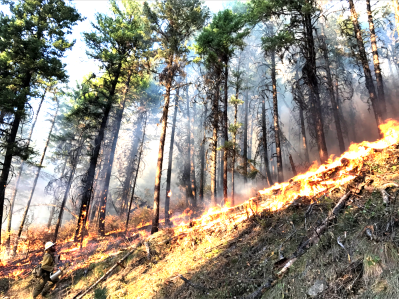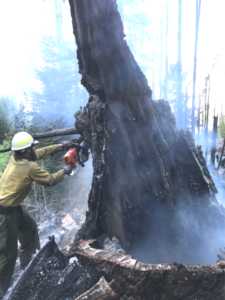Westfork Fire control burn season 2018. Photo courtesy of Anna Valentine, of Troy, Mont.
By Brian Baxter
May is Wildfire Awareness Month and Montanans need to be alert to increasing fire dangers as we approach the summer season. First, if one lives in the Wildland Urban Interface, it’s a good practice to become familiar with what it takes to protect your home from wildfire. Mainly, homeowners should limit the amount of fuel that could bring flames and embers dangerously close to their properties and homes. It’s recommended that homeowners create three defensible zones around their homes. Residents should limit the amount of combustible items on their property and use and maintain non-combustible vegetation and mulch. With this in mind, creating safe zones at 0-5 ft.; 5-30 ft.; and 30-100 ft. or to your property line are recommended.
Use roof coverings with materials that won’t result in fire penetrating completely through the roof covering and sheathing into the attic space.
Also, it is recommended to clean flammable materials from gutters. Gutters filled with debris can be ignited by traveling embers propelled by wind or firestorms. Once ignited, the roof and facia can be exposed to direct flames.
Having dual paned, tempered glass windows offers the best protection from fire. Keep windows closed during adjacent wildfires. Choose non-combustible siding. Outdoor decks can draw in close proximity wildfires, especially with steep slopes that have combustible materials stored underneath, and highly flammable deck building materials.
Another goal of fire prevention programs is to reduce the number of human caused wildfires. One careless person can damage hundreds of thousands of acres. In some cases, if the individual is found to be responsible through modern fire science methods and detective work, they can be charged with the total cost of agency fire fighting expenses. These costs can go into millions of dollars. The public is encouraged to self educate by going online and researching fire prevention programs such as Keep Montana Green; Firesafe Montana; Firewise Communities; and the Ready, Set, Go protocol. Educate your family and children on how to avoid starting wildfires. Human caused wildland fires are usually caused by campfires; smoking; burning debris; arson; children playing with matches; fireworks; faulty equipment; railroads, or gas and oil carelessness.
Our local agency Fire Prevention Officers and local Volunteer Fire Departments are on hand to give advice and assist the citizenry. Check to see if you are eligible for a Fire Hazard Reduction Agreement on your land and around your home by calling the Lincoln County Office of Environmental Health at 283-2442. For information on Best Management Practices call the Montana State University Extension Service at (406)296-9019. To call the local U.S. Forest Service Supervisor’s Office dial 293-6211. To call the Montana Department of Natural Resources and Conservation’s local office call 293-2711.
A word to the wise is sufficient is how the old saying goes, and according to the National Interagency Fire Center in Boise, Idaho as of May 1, the Northern Rockies can expect normal significant large fire potential during the outlook period from May through August. The exception is the northern Idaho Panhandle where above normal significant large fire potential is expected in July and August. We on the Kootenai Forest in Lincoln and Sanders Counties border the Idaho Panhandle Forests that include the Kaniksu National Forest.
Mountain snowpack levels over the western areas continue though overall levels are decreasing due to compaction and slow melting. Levels are now just slightly below average across northern Idaho and northwestern Montana. Regionwide, U.S. Drought Monitor maintains drought free conditions, but abnormally dry area is highlighted across northern Idaho and northwestern Montana, which will need monitoring.
Dane Wales of the wildland firefighter for US forest service is securely sawing down an burnt Douglas fir snag stump in 2018. Photo courtesy of Anna Valentine, of Troy, Mont.


